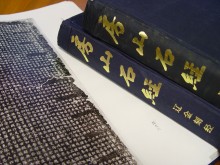|
 From the years 605-617 A.D. (Daye era, Sui dynasty), the monk Jingwan, , in keeping the wish of his teacher Nanyue Huisi, started the tripitaka stone carving in Fangshan (in Beijing) in case the Buddhist canons were ever destroyed. The carving of Fangshan Shijing (Fangshan Stone Tripitaka) was started by Jingwan and continued through the Sui, Tang, Liao, Jin and Ming dynasties (during the Yuan dynasty only a few individual repairs were done to the carving).
From the years 605-617 A.D. (Daye era, Sui dynasty), the monk Jingwan, , in keeping the wish of his teacher Nanyue Huisi, started the tripitaka stone carving in Fangshan (in Beijing) in case the Buddhist canons were ever destroyed. The carving of Fangshan Shijing (Fangshan Stone Tripitaka) was started by Jingwan and continued through the Sui, Tang, Liao, Jin and Ming dynasties (during the Yuan dynasty only a few individual repairs were done to the carving).
This carving project was supported and sponsored by generations of imperial families, government officials, and followers of Buddhism. In 730 A.D. (Kaiyuan era, Tang dynasty), princess Jinxian petitioned Emperor Xuanzong to sponsor a carving project of about 4000 newly translated Buddhist scriptures. Monk Zhisheng of Western Chongfu Temple was dispatched to deliver the translations to Fangshan. This explains why the Fangshan Shijing contains many of the Buddhist transcripts found in the imperial palace of Tang dynasty.
However, the Fangshan Shijing was not carved according to the original content order of the tripitaka. More often than not the engravers carved only what they wanted to carve. As a result, some famous tripitaka were repeatedly carved, such as the Vajracchedika Tripitaka (the Diamond Tripitaka or Jingangjing) and the Prajnaparamita Tripitaka. All repetitions excluded, only around 1100 texts were actually carved, with many partially finished. Some even belong to Taoist canons.
Though the Fangshan Shijing is not a complete collection of tripitaka, it has its own distinguishing features:
1. It preserved more than 50 canons that are not found in other tripitaka.
2. Most of the carvings were done in graceful calligraphic styles, making Fangshan Shijing not just valuable as a Buddhist text, but as an artistic work of Chinese calligraphy and carving.
3. Approximately 6000 inscriptions were left on the stones. One fourth of them record the year of carving. This can help provide clues into the political, economic and cultural conditions, as well as the industrial and business developments of the time in about 10 counties, including Youzhou, Zhuozhou, and Fanyang.
4. Many engravers were military and civilian officials. The names they left on the stones can supplement and help authenticate other historical materials from the time.
5. The inscriptions designate the engravers’ ancestral hometowns as well as the locations they lived. These pieces of information provide valuable insight into the past administrative demarcation of the Youzhou, Yanjing, and Zhuozhou areas, and the city layout of Yanjing in particular.
This digital database collects the catalogue of the Fangshan Shijing.
Digital Database of Buddhist Tripitaka Catalogues,
Dharma Drum Buddhist College
|